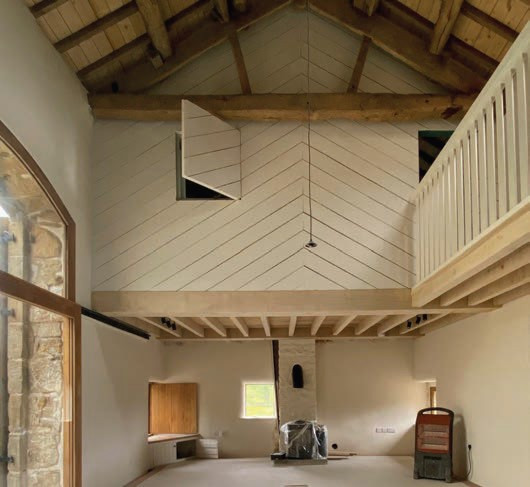Going local
26 October 2023Structural engineer and timber technologist Iain Thew looks at the role for UK hardwoods in construction
As a structural engineer working in a company with a particular interest in timber construction, it has been heartening to see the revival of interest in traditional oak framing over the past few decades. The large number of historic oak framed buildings across the country gives a clear indication of the longevity of such buildings when they are properly detailed.
There are also many advantages to oak framing in a modern context, including the use of traditional pegged joints, which removes the need for more carbon intense steel xings, and offsite prefabrication, which allows better quality control, and reduced time onsite for the construction phase.
But do we always need to be specifying oak? Traditionally oak has been by far the most common hardwood timber used in construction. Elm and sweet chestnut have also been specied, but to a much lesser extent. The use of oak made a lot of sense historically, as buildings were prone to issues with damp and water ingress, and durability was an important consideration.
However, modern forms of construction provide much drier internal environments, and structural frames can be completely enclosed and protected from the weather. There are no compelling reasons preventing other hardwoods, such as beech, ash and sycamore from being used more widely in UK construction. In BS EN 1912 there are strength classes for German-grown beech, ash and maple. Beech and ash are in fact stronger than the equivalent visual strength grades for oak, and maple can be also graded to D30, so the potential for their utilisation in structures and buildings is clear.
So why aren’t we using more locally sourced hardwoods? They have lower embodied carbon due to reduced transportation and provide a better use for what is increasingly being recognised as a valuable resource. Using hardwoods in construction can divert timber away from use as rewood, the fate of the majority of hardwood timber harvested in the UK at present.
As a practice our interest in UK hardwoods began when our director Robert Thorniley-Walker saved some sycamore and ash logs, which were destined for rewood, and processed them into boxed heart beams.
Since then, they have been used for roof purlins, lintels, mantels over replaces and -oor beams. As UK strength classes are not available for these species, our designs are based on experience gained from physical load testing. Our more recent projects include the design of a new rst -oor structure made from sycamore in a barn conversion at Hoggerstone Farm in the Yorkshire Dales (designer Tom Bromet of Donald Insall Associates) and a new beech-framed structure for the Swinton Estate.
There is currently a wide disparity in the utilisation of UK-grown softwoods and hardwoods. Just under 50% of UK woodland is broadleaf forest, yet Forest Research reported that only 0.8 million green tonnes of hardwoods were harvested in 2022, compared to 9.2 million green tonnes of softwoods.
Planting of hardwoods is now overtaking softwoods, and the Forestry Commission (FC) is projecting that availability of UK-grown hardwoods will rise by 750% from 2013- 16 to 2042-46. With this expected increase in availability, further research is going to be vital to realise the full potential of the hardwood resources we have in this country. It is heartening to see that the FC has recognised this requirement and is funding a three-year research project Building from England’s Woodlands, focused on improving knowledge on the use of UK hardwoods in construction (https://www.be-st.build/news/ english-woodlands-could-provide-newnatural- construction-resource).

